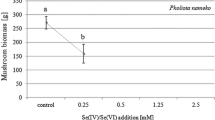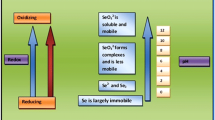Abstract
Selenium (Se) is an essential trace element with multiple functions that may help mitigate adverse health conditions. Cordyceps militaris is an edible mushroom with medicinal properties. The experiment was conducted under artificial cultivation, with five Se concentrations (0, 5, 10, 20, and 40 μg g−1) and three forms of Se (selenate, selenite, and selenomethionine). C. militaris can absorb inorganic from the substrate and convert it to organic Se compounds (selenocystine, selenomethionine, and an unknown species) in fruiting bodies. Compared with the control treatment, Se applications (40 μg g−1 selenate and selenite) significantly increased the Se concentration in fruiting bodies by 130.9 and 128.1 μg g−1, respectively. The biofortification with selenate and selenite did not affect fruiting body production, in some case, but did enhance the biological efficiency. Moreover, the abundance of cordycepin and adenosine increased, while the amino acid contents remained relatively stable. Meanwhile, Se-biofortified C. militaris showed effective antioxidant activities. These results suggest that Se-biofortified C. militaris fruiting bodies may enhance human and animal health when it was included as part of a healthy diet or used as Se supplements.





Similar content being viewed by others
References
Reilly C (2006) Selenium in food and health, 2nd edn. Springer, New York, pp 20–40. https://doi.org/10.1007/978-0-387-33244-4
Fairweather-Tait SJ, Bao YP, Broadley MR, Collings R, Ford D, Ford D, Hesketh JE, Hurst R (2011) Selenium in human health and disease. Antioxid Redox Signal 14(7):1337–1383. https://doi.org/10.1089/ars.2010.3275
Fordyce FM (2013) Selenium deficiency and toxicity in the environment. In: Selinus O (ed) Essentials of medical geology. Springer, Dordrecht, pp 375–415. https://doi.org/10.1007/978-94-007-4375-5_16
Stranges S, Sieri S, Vinceti M, Grionic S, Guallar E, Laclaustra M, Muti P, Berrino F, Krogh V (2010) A prospective study of dietary selenium intake and risk of type 2 diabetes. BMC Public Health 10(1):564. https://doi.org/10.1186/1471-2458-10-564
Tanguy S, Grauzam S, Leiris J, Boucher F (2012) Impact of dietary selenium intake on cardiac health: experimental approaches and human studies. Mol Nutr Food Res 56(7):1106–1121. https://doi.org/10.1002/mnfr.201100766
Food and Nutrition Board (2000) Dietary reference intakes for vitamin C, vitamin E, selenium, and carotenoids. Institute of Medicine, National Academic Press, Washington, DC. https://doi.org/10.17226/9810
Arnault I, Auger J (2006) Seleno-compounds in garlic and onion. J Chromatogr A 1112(1–2):23–30. https://doi.org/10.1016/j.chroma.2006.01.036
Weekley CM, Harris HH (2013) Which form is that? The importance of selenium speciation and metabolism in the prevention and treatment of disease. Chem Soc Rev 42(23):8870–8894. https://doi.org/10.1039/c3cs60272a
EI-Ramady HR, Domokos-Szabolcsy É, Abdalla NA, Alshaal TA, Shalaby TA, Sztrik A, Prokisch J, Fári M (2014) Selenium and nono-selenium in agroecosystems. Environ Chem Lett 12(4):495–510. https://doi.org/10.1007/s10311-014-0476-0
Wang YD, Wang X, Wong YS (2013) Generation of selenium-enriched rice with enhanced grain yield, selenium content and bioavailability through fertilization with selenite. Food Chem 141(3):2385–2393. https://doi.org/10.1016/j.foodchem.2013.05.095
Burk RF, Norsworthy BK, Hill KE, Motley AK, Byrne DW (2006) Effects of chemical form of selenium on plasma biomarkers in a high-dose human supplementation trial. Cancer Epidemiol Biomark Prev 15(4):804–810. https://doi.org/10.1158/1055-9965.EPI-05-0950
Barger JL, Kayo T, Pugh TD, Vann JA, Power R, Dawson K, Weindruch R, Prolla TA (2012) Gene expression profiling reveals differential effects of sodium selenite, selenomethionine, and yeast-deriver selenium in mouse. Genes Nutr 7(2):155−165–155−165. https://doi.org/10.1007/s12263-011-0243-9
Dumont E, Vanhaecke F, Cornelis R (2006) Selenium speciation from food source to metabolites: a critical review. Anal Bioanal Chem 385(7):1304–1323. https://doi.org/10.1007/s00216-006-0529-8
Hartikainen H (2005) Biogeochemistry of selenium and its impact on food chain quality and human health. J Trace Elem Med Biol 18(4):309–318. https://doi.org/10.1016/j.jtemb.2005.02.009
Bhatia P, Aureli F, D’Amato M, Prakash R, Cameotra SS, Nagaraja TP, Cubadda F (2013) Selenium bioaccessibility and speciation in biofortified Pleurotus mushrooms grown on selenium-rich agricultural residues. Food Chem 140(1–2):225–230. https://doi.org/10.1016/j.foodchem.2013.02.054
da Silva MCS, Naozuka J, da Luz JMR, de Assunção LS, Oliveira PV, Vanetti MCD, Bazzolli DMS, Kasuya MCM (2012) Enrichment of Pleurotus ostrestus mushrooms with selenium in coffee husks. Food Chem 131(2):558–563. https://doi.org/10.1016/j.foodchem.2011.09.023
Maseko T, Callahan DL, Dunshea FR, Doronila A, Kolev SD, Ng K (2013) Chemical characterization and speciation of organic selenium in cultivated selenium-enriched Agaricus bisporus. Food Chem 141(4):3681–3687. https://doi.org/10.1016/j.foodchem.2013.06.027
Rzymski P, Mleczek M, Niedzielski P, Siwulski M, Gąsecka M (2016) Potential of cultivated Ganoderma lucidum mushrooms for the production of supplements enriched with essential elements. J Food Sci 81(3):C587–C582. https://doi.org/10.1111/1750-3841.13212
Rzymski R, Mleczek M, Niedzielski P, Siwulski M, Gąsecka M (2016) Cultivation of Agaricus bisporus, enriched with selenium, zinc and copper. J Sci Food Agric 97(3):923–928. https://doi.org/10.1002/jsfa.7816
Niedzielski P, Mleczek M, Siwulski M, Rzymski P, Gasecka M, Kozak L (2015) Supplementation of cultivated mushroom species with selenium: bioaccumulation and speciation study. Eur Food Res Technol 241(3):419–426. https://doi.org/10.1007/s00217-015-2474-2
Poniedziałek B, Mleczek M, Niedzielski P, Siwulski M, Gąsecka M, Kozak L, Komosa A, Rzymski P (2017) Bio-enriched Pleurotus mushrooms for deficiency control and improved antioxidative protection of human platelets? Eur Food Res Technol 243(12):2187–2198. https://doi.org/10.1007/s00217-017-2921-3
Paterson RRM (2008) Cordyceps—a traditional Chinese medicine fungal therapeutic biofactory? Phytochemistry 39(31):1469–1495. https://doi.org/10.1016/j.phytochem.2008.01.027
Das SK, Masuda M, Sakurai A, Sakakibara M (2010) Medicinal uses of the mushroom Cordyceps militaris: current state and prospects. Fitoterapia 81(8):961–968. https://doi.org/10.1016/j.fitote.2010.07.010
Arnold MC, Lindberg TT, Liu YT, Porter KA, Hsu-Kim H, Hinton DE, Giulio RTD (2014) Bioaccumulation and speciation of selenium in fish and insects collected from a mountaintop removal coal mining-impacted stream in West Virgina. Ecotoxicology 23(5):929–938. https://doi.org/10.1007/s10646-014-1236-4
Sung GH, Hywel-Jones NL, Sung JM, Luangsa-Ard JJ, Shrestha B, Spatafora JW (2007) Phylogenetic classification of Cordyceps and clavicipitaceous fungi. Stud Mycol 57(57):5–59. https://doi.org/10.3114/sim.2007.57.01
Chiu C, Liu S, Tang C, Chan Y, El-Shazly M, Lee CL, Du YC, Wu TY, Chang FR, Wu YC (2016) Anti-inflammatory cerebrosides from cultivated Cordyceps militaris. J Agric Food Chem 64(7):1540–1548. https://doi.org/10.1021/acs.jafc.5b05931
Kang HJ, Baik HW, Kim SJ, Lee SG, Ahn HY, Park JS, Park SJ, Jang EJ, Park SW, Choi JY, Sung JH, Lee SM (2015) Cordyceps militaris enhances cell-mediated immunity in healthy Korean men. J Med Food 18(10):1164–1172. https://doi.org/10.1089/jmf.2014.3350
Shao L, Huang L, Yan S, Jin J, Ren S (2016) Cordycepin induces apoptosis in human liver cancer HepG2 cells through extrinsic and intrinsic signaling pathways. Oncol Lett 12(2):995–1000. https://doi.org/10.3892/ol.2016.4706
Zhang G, Liang Y (2013) Improvement of fruiting body production in Cordyceps militaris by molecular assessment. Arch Microbiol 195(8):579–585. https://doi.org/10.1007/s00203-013-0904-8
Wang DX, Sakoda A, Suzuki M (2001) Biological efficiency and nutritional value of Pleurotus Ostreatus cultivated on spent beer grain. Bioresour Technol 78(3):293–300. https://doi.org/10.1016/S0960-8524(01)00002-5
Baldwin S, Deaker M, Maher W (1994) Low-volume microwave digestion of marine biological tissues for measurement of trace elements. Analyst 119(8):1701–1704. https://doi.org/10.1039/an9941901701
Montes-Bayón M, Molet MJD, González EB, Sanz-Medel A (2006) Evaluation of different sample extraction strategies for selenium determination in selenium-enriched plants (Allium sativum and Brassica juncea) and Se speciation by HPLC-ICP-MS. Talanta 68(4):1287–1293. https://doi.org/10.1016/j.talanta.2005.07.040
Li JM, Guan MY, Li Y (2015) Effects of cooking on the contents of adenosine and cordycepin in Cordyceps militaris. Procedia Eng 102:485–491. https://doi.org/10.1016/j.proeng.2015.01.195
Oser BL (1959) An integrated essential amino acid index for predicting the biological value of proteins. In: Albanese AA (ed) Protein and amino acids in nutrition. Academic Press, New York, pp 281–295. https://doi.org/10.1016/B978-0-12-395683-5.50014-6
Cheung LM, Cheung PCK, Ooi VEC (2003) Antioxidant activity and total phenolics edible mushroom extracts. Food Chem 81(2):249–255. https://doi.org/10.1016/S0308-8146(02)00419-3
de Souza MP, Pilon-Smits EAH, Lytle CM, Hwang S, Tai HJ, Honma TS, Yeh L, Terry N (1998) Rate-limiting steps in selenium assimilation and volatilization by Indian mustard. Plant Physiol. 117(4):1487–1494. https://doi.org/10.1104/pp.117.4.1487
Sors TG, Ellis DR, Salt DE (2005) Selenium uptake, translocation, assimilation and metabolic fate in plants. Photosynth Res 86(3):373–389. https://doi.org/10.1007/s11120-005-5222-9
Egressy-Molnár O, Ouerdane L, Győrfi J, Dernovics M (2016) Analogy in selenium enrichment and selenium speciation between selenized yeast Saccharomyces cerevisiae and Hericuium erinaceus (Lion’s mane mushroom). LWT - Food Sci Technol 68:306–312. https://doi.org/10.1016/j.lwt.2015.12.028
Schrauzer GN (2000) Selenomethionine: a review of it nutritional significance metabolism and toxicity. J Nutr 130(7):1653–1656. https://doi.org/10.1093/jn/130.7.1653
Kitajima T, Chiba Y (2013) Selenomethionine metabolism and its toxicity. Biomol Concepts 4(6):611–616. https://doi.org/10.1515/bmc-2013-0033
Zhang H, Zhang H, Han L, Wang S (2014) Cultivation technique of selenium-enriched Cordyceps militaris. Appl Mech Mater 522–524:1147–1150. https://doi.org/10.4028/www.scientific.net/AMM.522-524.1147
Fan DD, Wang W, Zhong JJ (2012) Enhancement of cordycepin production in submerged cultures of Cordyceps militaris by addition of ferrous sulfate. Biochem Eng J 60(2):30–35. https://doi.org/10.1016/j.bej.2011.09.014
Kredich NM, Guarino AJ (1961) Studies on the biosynthesis of cordycepin. Biochim Biophys Acta 47(3):529–534. https://doi.org/10.1016/0006-3002(61)90546-7
Turlo J, Gutkowska B, Herold F (2010) Effect of selenium enrichment on antioxidant activities and chemical composition of Lentinula edodes (Berk.) Pegl. Mycelia extracts. Food Chem Toxicol 48(4):1085−1091–1085−1091. https://doi.org/10.1016/j.fct.2010.01.030
Peñaflorida VD (1989) An evaluation of indigenous protein sources as potential component in the diet formulation for tiger prawn, Penaeus monodon, using essential amino acid index (EAAI). Aquaculture 83(3–4):319–330. https://doi.org/10.1016/0044-8486(89)90043-4
Cho J, Kang JS, Long PH, Jing J, Back Y, Chung KS (2003) Antioxidant and memory enhancing effects of purple sweet potato anthocyanin and cordyceps mushroom extract. Arch Pharm Res 26(10):821–825. https://doi.org/10.1007/BF02980027
Li SP, Li P, Dong TTX, Tsim KWK (2001) Anti-oxidation activity of different types of natural Cordyceps sinensis and cultured Cordyceps mycelia. Phytomedicine 8(3):207–212. https://doi.org/10.1078/0944-7113-00030
Reis FS, Martins A, Barros L, Ferreira ICFR (2002) Antioxidant properties and phenolic profile of the most widely appreciated cultivated mushrooms: a comparative study between in vivo and vitro samples. Food Chem Toxicol 50(5):1201–1207. https://doi.org/10.1016/j.fct.2012.02.013
Rotruck JT, Pope AL, Ganther HE, Swanson AB, Hafeman DG, Hoekstra WG (1973) Selenium: biochemical role as a component of glutathione peroxidase. Science 179:588–590. https://doi.org/10.1126/science.179.4073.588
Ganther HE (1986) Pathways of selenium metabolism including respiratory excretory products. Int J Toxicol 5(1):1–5. https://doi.org/10.3109/10915818609140731
Jacob C, Giles GI, Giles NM, Sies H (2003) Sulfur and selenium: the role of oxidation state in protein structure and function. Angew Chem Int Ed 42(39):4742–4758. https://doi.org/10.1002/anie.200300573
Wu J, Lyons GH, Graham RD, Fenech MF (2009) The effect of selenium, as selenomethionine, on genome stability and cytotoxicity in human lymphocytes measured using the cytokinesis-block micronucleus cytome assay. Mutagenesis 24(3):225–232. https://doi.org/10.1093/mutage/gen074
Acknowledgments
This work was supported by the Special Fund for Agro-scientific Research in the Public Interest (201303106), the National Natural Science Foundation of China (31470531), the Program for Liaoning Excellent Talents in University (LR2015058), and the Scientific Research Foundation for the Introduced Talents of Shenyang Agricultural University (20153040).
Author information
Authors and Affiliations
Corresponding author
Electronic Supplementary Material
Figure S1
Biomass production in fruiting bodies treated with different concentrations of selenate [Se (VI)], selenite [Se (IV)], or selenomethionine (SeMet). Control treatments lacked Se in the medium. Data are mean ± SD (n = 3). Different letters (a, b, c…) indicate significant differences among Se treatments (p < 0.05). (GIF 39 kb)
Table S1
(DOCX 42 kb)
Rights and permissions
About this article
Cite this article
Hu, T., Liang, Y., Zhao, G. et al. Selenium Biofortification and Antioxidant Activity in Cordyceps militaris Supplied with Selenate, Selenite, or Selenomethionine. Biol Trace Elem Res 187, 553–561 (2019). https://doi.org/10.1007/s12011-018-1386-y
Received:
Accepted:
Published:
Issue Date:
DOI: https://doi.org/10.1007/s12011-018-1386-y




